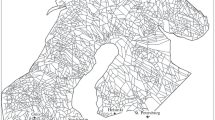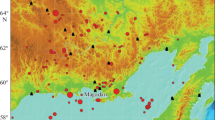Abstract
It is shown that different well-known models of earthquake sources explain the origin of a particular seismic event, but they do not reflect the overall geodynamic situation in a seismic zone and they cannot be used for understanding the regular patterns of the seismic process as a whole and for its prediction. On the basis of well-studied fractural tectonics and seismicity of the Baikal rift system, a tectonophysical model of seismic zone is proposed. The conceptual basis of the tectonophysical model of a seismic zone is as follows: the fracture-block medium of the brittle part of the lithosphere, the sufficiently frequent activation of faults of different ranks in real time, initiated by the deformation waves of different lengths and velocities, and seismic events consecutively proceeding predominantly along one of the directions of the specific activated faults. A seismic process in any particular part of the zone can be stimulated by the presence of fluids, by induced seismicity or by other factors. The developed tectonophysical model of the seismic process offers the possibilities of the utilization of the contemporary geo-information systems for the calculations during the assigned time interval of the sequential regular patterns of activations of faults, and within the boundaries of the regions of their dynamic influence, the succession of the appearance of separate sources. The model and the theoretically possible calculations on its basis bring one closer to the medium- and short-term prediction of earthquakes.
Similar content being viewed by others
References
V. L. Barabanov, A. O. Grinevskii, I. G. Kissin, and M. R. Mil’kis, “Manifestations of Deformation Waves under the Hydrogeological and Seismic Conditions of the Zone of Foremost Kopet Dagh Fault,” Izv. Akad. Nauk SSSR, Ser. Fizika Zemli, No. 5, 21–31 (1988).
F. H. R. Bezerra, M. K. Takeya, M. O. L. Sousa, and F. N. Anderson, “Coseismic Reactivation of the Samambaia Fault, Brazil,” Tectonophysics, 430 27–39 (2007).
V. G. Bykov, “Deformation Waves of the Earth: Concept, Observations and Models,” Geologiya i Geofizika, 46(11), 1176–1190 (2005).
A. V. Chipizubov, Reconstruction and Prediction of Changes in the Earth’s Seismicity (Institute of Earth’s Crust, Siberian Branch, Russian Academy of Sciences, 2008) pp. 1–240.
R. Console, M. Murru, and F. Catalli, “Physical and Stochastic Models of Earthquake Clustering,” Tectonophysics, 417, 141–153 (2006).
I. P. Dobrovol’skii, Theory of Tectonic Earthquake Preparation (Institute of Physics of the Earth, Russian Academy of Sciences, Moscow, 1991) pp. 1–217.
P. G. Dyad’kov, V. I. Mel’nikova, L. A. Nazarov, et al., “Seismotectonic Activation of the Baikal Region in 1989–1995: The Results of Experimental Observations and The Numerical Modeling of Changes in the Stress-Strain State,” Geologiya i Geofizika, 40(3), 373–386 (1999).
M. D. Finna, M. R. Grossa, Y. Eyalb, and G. Drapera, “Kinematics of Throughgoing Fractures in Jointed Rocks,” Tectonophysics, 376, 151–166 (2006).
A. G. Gamburtsev, Seismic Monitoring of Lithosphere (Nauka, Moscow, 1992) pp. 1–200.
V. I. German, “Unified Scaling Theory for Distributions of Temporal and Spatial Characteristics in Seismology,” Tectonophysics, 424, 167–175 (2006).
N. A. Gileva, V. I. Melnikova, N. A. Radziminovich, and J. Deversher, “Localization of Earthquakes and the Mean Characteristics of the Earth’s Crust in Some Regions of the Baikal Region,” Geologiya i Geofizika, 41(5), 629–636 (2000).
S. V. Gol’din, “Destruction of Lithosphere and Physical Mesomechanics,” Fizicheskaya Mesomekhanika, 5(5), 5–22 (2002).
S. V. Gol’din, P. G. Dyad’kov, and Yu. A. Dashevskii, “Strategy of Earthquake Prediction on the Southern Baikal Geodynamic Research Area,” Geologiya i Geofizika, 42(10), 1484–1496 (2001).
K. Jonsdottir, M. Lindman, R. Roberts, Bjorn Lund, and R. Bodvarsson, “Modelling Fundamental Waiting Time Distributions for Earthquake Sequences,” Tectonophysics, 424, 195–208 (2006).
K. Kasahara, “Migration of Crustal Deformation,” Tectonophysics, 52, 329–341 (1979).
Y.-S. Kim and J.-H. Choi, “Fault Propagation, Displacement and Damage Zones,” in Conference Commemorating the 1957 Gobi-Altay Earthquake. Ulaanbaatar, Mongolia (2007) pp. 81–86.
I. G. Kissin, “The New Data on the “Sensitive Zones” of the Earth’s Crust and the Formation of the Earthquake Precursors and Postseismic Effects,” Geologiya i Geofizika, 48(5), 548–565 (2007).
G. G. Kocharyan and A. A. Spivak, The Deformation Dynamics of the Block Rock Massifs (ITSK “Akademkniga”, Moscow, 2003) pp. 1–423.
B. V. Kostrov, Source Mechanics of Tectonic Earthquake (Nauka, Moscow, 1975) pp. 1–176.
Yu. O. Kuz’min, Contemporary Geodynamics of Fault Zones,” Fizika Zemli, No. 10, 95–111 (2004).
Yu. O. Kuz’min and V. S. Zhukov, Modern Geodynamics and Variations in the Physical Properties of the Rocks (Publishing House of the Moscow State Mining University, Moscow, 2004) pp. 1–262.
A. A. Lukk, A. V. Deshcherevskii, A. Ya. Sidorin, and I. A. Sidorin, Variations in Geophysical Fields as the Manifestation of Deterministic Chaos in the Fractal Medium (Institute of Physics of the Earth, Russian Academy of Sciences, Moscow, 1996) pp. 1–210.
O. V. Lunina, “The Influence of the Stress State of Lithosphere on the Relationships of the Parameters of Seismogenic Faults and Earthquake Magnitudes,” Geologiya i Geofizika, 42(9), 1389–1398 (2001).
A. S. Malamud, and V. N. Nikolaevskii, Earthquake Cycles and Tectonic Waves (Publishing House “Donish”, Dushanbe, 1989) pp. 1–144.
Shozo Matsumura, “Seismic Activity Changes Progressing Simultaneously with Slow-Slip in the Tokai Area,” Tectonophysics, 417, 5–15 (2006).
R. Meissner and H. Kern, “Earthquakes and Strength in the Laminated Lower Crust-Can They be Explained by the “Corset Model”?,” Tectonophysics, 448, 49–59 (2008).
V. I. Myachkin, Earthquake Nucleation Processes (Nauka, Moscow, 1978) pp. 1–232.
V. N. Nikolaevskii and T. K. Ramazanov, “Generation and Propagation of Waves along the Deep Faults,” Izv. Akad. Nauk SSSR, Ser. Fiz. Zemli, No. 10, 3–13 (1986).
A. A. Nikonov, “Migration of Strong Earthquakes along the Main Fault Zones of Central Asia,” Dokl. Akad. Nauk SSSR, 255(2), 306–309 (1975).
A. A. Nikonov, “Migration of Large Earthquakes along the Great Fault Zones in Middle Asia,” Tectonophysics, 31, 55–60 (1976).
Yu. L. Rebetskii, Tectonic Stresses and the Strength of Natural Rock Massifs (ITSK “Akademkniga”, Moscow, 2007) pp. 1–406.
Yu. V. Riznichenko, Problems of Seismology. Selected Transactions (Nauka, Moscow, 1985) pp. 1–408.
M. V. Rodkin, “The Problem of the Earthquake Source Physics: Contradictions and Models,” Fizika Zemli, No. 8, 42–52 (2001).
E. A. Rogozhin, A. N. Ovsyuchenko, A. V. Marakhanov, and E. A. Ushanova, “Tectonic Position and Geological Manifestations of Altai Earthquake of 2003,” Geotektonika, No. 2, 3–23 (2007).
E. A. Rogozhin, A. N. Ovsyuchenko, and A. V. Marakhanov, “Strongest Earthquakes in the South of the Mountain Altai in Holocene,” Fizika Zemli, No. 6, 31–51 (2008).
E. A. Rogozhin and S. G. Platonov, Source Zones of the Strong Earthquakes of the Mountain Altai in Holocene (Institute of Physics of the Earth, Russian Academy of Sciences, Moscow, 2002) pp. 1–130.
V. V. Ruzhich, Seismotectonic Destruction in the Earth’s Crust of Baikal Rift Zone (Publishing House of the Siberian Branch of the Russian Academy of Sciences, Novosibirsk, 1997) pp. 1–144.
M. A. Sadovskii, L. G. Bolkhovitinov, and V. F. Pisarenko, Deformation of Geophysical Medium and Seismic Process (Nauka, Moscow, 1980) pp. 1–100.
C. H. Scholz, The Mechanics of Earthguakes and Faulting, 2nd ed. (Cambridge Univ. Press. New York, 2002).
S. I. Sherman, Physical Regularities of the Development of the Earth’s Crust Fault (Nauka, Siberian Branch, Novosibirsk, 1977) pp. 1–102.
S. I. Sherman, “The Development of the Ideas of M. V. Gzovskii in the Contemporary Tectonophysical Studies of Faulting and Seismicity in the Lithosphere,” in Tectonophysics Today (to the Anniversary of M. V. Gzovskii) (Institute of Physics of the Earth, Russian Academy of Sciences, Moscow, 2002) pp. 49–59.
S. I. Sherman, “The New Data on the Regular Patterns of Activation of the Faults in the Baikal Rift System and in the Adjacent Territory,” Dokl. Akad. Nauk, 415(1), 110–114 (2007).
S. I. Sherman, S. A. Bornyakov, and V. Yu. Buddo, The Regions of Dynamic Influence of Faults (Nauka, Siberian Branch, Novosibirsk, 1983) pp. 1–101.
S. I. Sherman, V. M. Dem’yanovich, and S. V. Lysak, “Active Faults, Seismicity and Fracturing in the Lithosphere of the Baikal Rift System,” Tectonophysics, 380(3–4), 261–272 (2004).
S. I. Sherman, V. M. Dem’yanovich, and S. V. Lysak, “Seismic Process and the Contemporary Multilevel Destruction of Lithosphere in the Baikal Rift Zone,” Geologiya i Geofizika, 45(12), 1458–1470 (2004).
S. I. Sherman, V. M. Dem’yanovich, and S. V. Lysak, “The New Data on the Contemporary Destruction of Lithosphere in the Baikal Rift Zone,” Dokl. Akad. Nauk, 387(4), 533–536 (2002).
S. I. Sherman and A. S. Gladkov, “Fractals in Studies of Faulting and Seismicity in the Baikal Rift Zone,” Tectonophysics, 308, 133–142 (1999).
S. I. Sherman and E. A. Gorbunova, “Wave Nature of Activation of the Faults of Central Asia on the Basis of Seismic Monitoring,” Fizicheskaya Mezomekhanika, 11(1), 115–122 (2008).
S. I. Sherman and K. G. Levi, “Transform Faults of the Baikal Rift Zone and Seismicity of its Wings,” in Tectonics and Seismicity of the Continental Rift Zones (Nauka, Moscow, 1978) pp. 7–18.
S. I. Sherman, A. P. Sorokin, and V. A. Savitskii, “The New Methods of Classification of the Seismoactive Faults of Lithosphere by the Index of Seismicity,” Dokl. Akad. Nauk, 401(3), 395–398 (2005).
G. A. Sobolev, Principles of Earthquake Prediction (Nauka, Moscow, 1993) pp. 1–313.
G. A. Sobolev, “The Dynamics of Fault Formation and Seismicity,” in Tectonophysics Today (Institute of Physics of the Earth, Russian Academy of Sciences, Moscow, 2002) pp. 67–78.
G. A. Sobolev and A. V. Ponomarev, Physics of Earthquakes and Precursors (Nauka, Moscow, 2003) pp. 1–270.
Shinji Toda and Shozo Matsumura, “Spatio-Temporal Stress States Estimated from Seismicity Rate Changes in the Tokai Region, Central Japan,” Tectonophysics, 417, 53–68 (2006).
V. G. Trifonov, “Specific Features of the Development of Active Faults,” Geotektonika, No. 2, 16–26 (1985).
V. I. Ulomov, “The Waves of Seismogeodynamic Activation and the Long-Term Earthquake Prediction,” Fizika Zemli, 43–53 (1993).
A. V. Vikulin, Introduction in Physics of the Earth. Tutorial for the Geophysical Specialties of Institutions of Higher Education (KGPU Publishing House, Petropavlovsk-Kamchatski, 2004) pp. 1–240.
A. V. Vikulin, Physics of Wave Seismic Process (KGPU Publishing House, Petropavlovsk-Kamchatski, 2003) pp. 1–151.
E. V. Vil’kovich, Sh. A. Guberman, and V. I. Keilis-Borok, “The Waves of Tectonic Deformations on the Large Faults,” Dokl. Akad. Nauk SSSR, 219(1), 77–80 (1974).
R. S. Yeats, K. Sieh, and C. R. Allen, The Geology of Earthquakes (Oxford University Press, New York, 1977) pp. 1–568.
V. S. Zakharov and O. V. Savchuk, “Self-Similar Properties of the Network of Active Faults and Seismicity,” in The General and Regional Problems of Tectonics and Geodynamics. Materials of the 41-st Conference of Interdepartmental Tectonic Committee (GEOS, Moscow, 2008) vol. 1, pp. 324–329.
A. D. Zav’yalov, Medium-Term Prediction of Earthquakes (Nauka, Moscow, 2006) pp. 1–254.
S. I. Zubkov, Earthquake Precursors (Institute of Physics of the Earth, Russian Academy of Sciences, Moscow, 2002) pp. 1–140.
Author information
Authors and Affiliations
Additional information
Original Russian Text © S.I. Sherman, 2009, published in Fizika Zemli, 2009, No. 11, pp. 8–21.
Rights and permissions
About this article
Cite this article
Sherman, S.I. A tectonophysical model of a seismic zone: Experience of development based on the example of the Baikal rift system. Izv., Phys. Solid Earth 45, 938–951 (2009). https://doi.org/10.1134/S1069351309110020
Received:
Published:
Issue Date:
DOI: https://doi.org/10.1134/S1069351309110020




